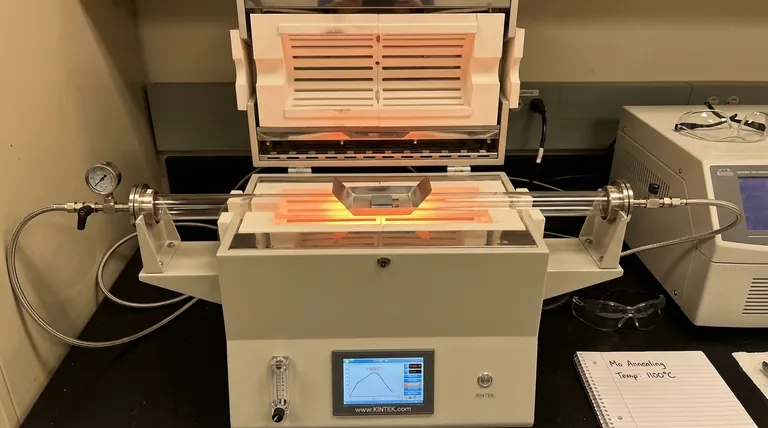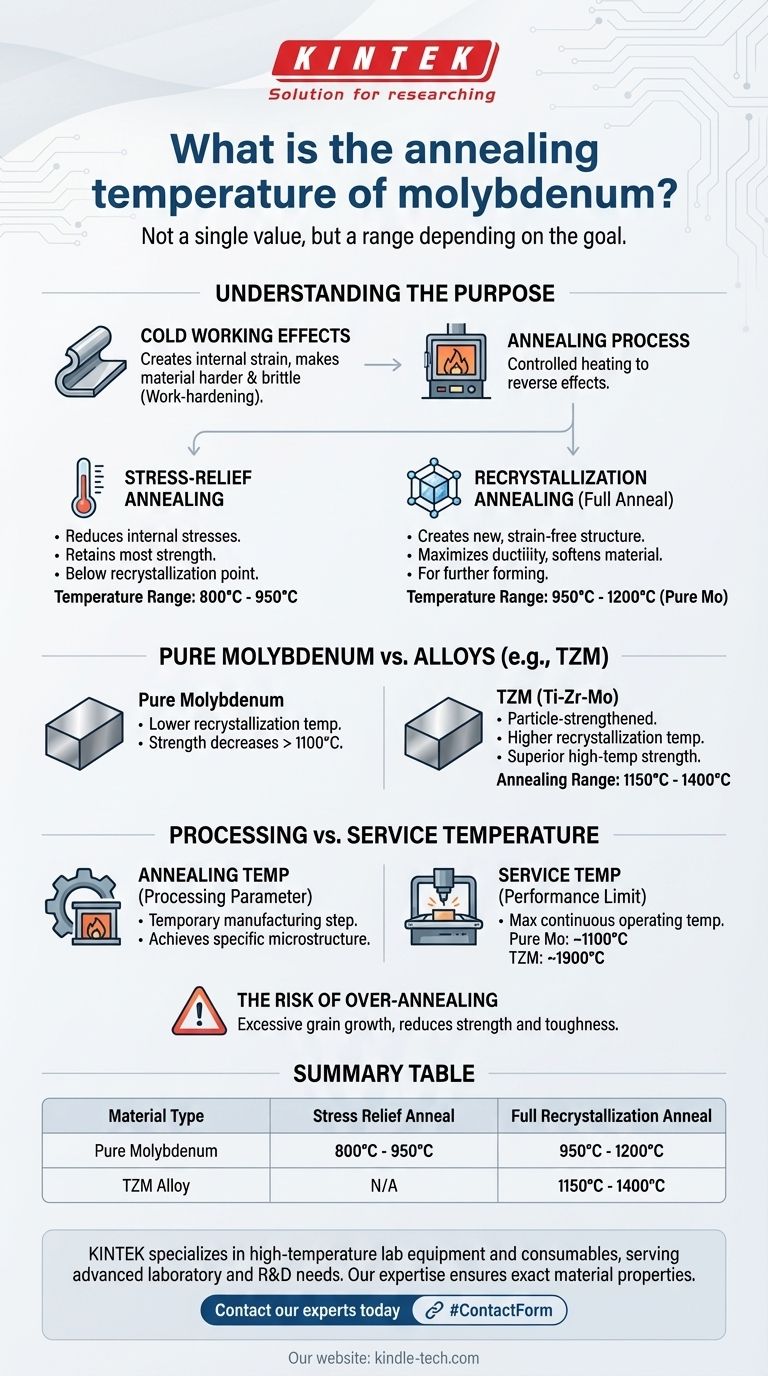For pure, previously worked molybdenum, the full annealing (recrystallization) temperature is not a single value but a range, typically between 950°C and 1200°C (1740°F and 2190°F). The exact temperature depends on the amount of prior cold work and the desired final grain structure. A lower-temperature stress relief anneal can be performed between 800°C and 950°C.
The term "annealing temperature" for molybdenum is imprecise. The correct temperature depends entirely on the goal—whether it's a low-temperature cycle to relieve internal stress or a higher-temperature cycle to fully reverse work-hardening and restore ductility.

Understanding the Purpose of Annealing Molybdenum
When molybdenum is mechanically formed, bent, or machined (a process known as cold working), its internal crystalline structure becomes strained. This makes the material harder and more brittle, a phenomenon called work-hardening.
Annealing is a controlled heating process designed to reverse these effects. It is not one single process but falls into two main categories.
Stress-Relief Annealing
This process is used to reduce the internal stresses built up during fabrication without significantly softening the material.
It is performed at a lower temperature, typically in the range of 800°C to 950°C. This is below the point of recrystallization, so the material retains most of the strength gained from work-hardening.
Recrystallization Annealing
This is what is commonly referred to as a "full anneal." The goal is to create a new, strain-free grain structure within the metal.
This process fully softens the material, maximizing its ductility and making it suitable for further forming. It requires a higher temperature, generally between 950°C and 1200°C for pure molybdenum.
Pure Molybdenum vs. Its Alloys
The user's question specified "molybdenum," but it's critical to distinguish between the pure element and its high-performance alloys. Additives fundamentally change the material's behavior at high temperatures.
Pure Molybdenum
Pure molybdenum offers excellent thermal and electrical conductivity but has a lower recrystallization temperature compared to its alloys. Its strength begins to decrease significantly at temperatures above 1100°C.
High-Performance Alloys (like TZM)
TZM (Titanium-Zirconium-Molybdenum) is a particle-strengthened alloy. The small additions of titanium and zirconium create fine carbide particles that pin the material's grain boundaries.
This structure gives TZM a much higher recrystallization temperature and superior strength (creep resistance) at elevated temperatures. The annealing temperature for TZM is consequently higher, often in the range of 1150°C to 1400°C.
Understanding the Trade-offs: Processing vs. Service Temperature
A common point of confusion is the difference between the temperature used to process a material and the temperature the final product can withstand.
Annealing Temperature: A Processing Parameter
Annealing is a temporary step in the manufacturing workflow. The material is heated to this temperature in a controlled environment (like a vacuum furnace) to achieve a specific microstructure and set of mechanical properties.
Service Temperature: A Performance Limit
The service temperature is the maximum temperature a finished component can operate at continuously without failing. For example, a pure molybdenum boat's recommended maximum service temperature is around 1100°C. Above this, it begins to soften and deform under load.
A TZM boat, due to the alloy's superior high-temperature strength, can have a service temperature up to 1900°C. Its higher annealing temperature is a direct reason for this superior performance.
The Risk of Over-Annealing
Using a temperature that is too high or holding the material at temperature for too long can be detrimental. This can cause excessive grain growth, which reduces the material's strength, toughness, and overall performance.
How to Apply This to Your Project
Choosing the correct thermal cycle is essential for achieving your desired outcome.
- If your primary focus is relieving stress after machining with minimal loss of hardness: Use a lower-temperature stress-relief anneal (approx. 800-950°C).
- If your primary focus is restoring maximum ductility for further forming: Use a full recrystallization anneal in the appropriate range for your material (e.g., 950-1200°C for pure Mo).
- If you are working with a TZM alloy: You must use a significantly higher annealing temperature to overcome its inherent high-temperature strength.
Controlling the thermal processing of molybdenum is the key to unlocking its intended mechanical properties.
Summary Table:
| Material Type | Stress Relief Anneal | Full Recrystallization Anneal |
|---|---|---|
| Pure Molybdenum | 800°C - 950°C | 950°C - 1200°C |
| TZM Alloy | N/A | 1150°C - 1400°C |
Need precise thermal processing for your molybdenum components?
KINTEK specializes in high-temperature lab equipment and consumables, serving advanced laboratory and R&D needs. Our expertise ensures you achieve the exact material properties—from stress relief to full recrystallization—for your specific application.
Contact our experts today to discuss your project requirements and discover the right solution for your lab.
Visual Guide

Related Products
- 1400℃ Laboratory Quartz Tube Furnace with Alumina Tube Tubular Furnace
- 1700℃ Laboratory Quartz Tube Furnace with Alumina Tube Tubular Furnace
- Molybdenum Vacuum Heat Treat Furnace
- 1800℃ Muffle Oven Furnace for Laboratory
- High Temperature Muffle Oven Furnace for Laboratory Debinding and Pre Sintering
People Also Ask
- What is a tubular furnace used for? Precision Heating for Material Synthesis & Analysis
- What are the benefits of a tube furnace? Achieve Superior Temperature & Atmosphere Control
- How does a tubular furnace work? A Guide to Controlled High-Temperature Processing
- What is a tube furnace used for? Achieve Precise, Controlled Thermal Processing
- What are the advantages of a tube furnace? Achieve Superior Temperature Uniformity and Control



















